The copper bismuth catalyst market is estimated at USD 72.3 million in 2025 and is anticipated to grow to USD 194.6 million by 2035, representing a strong CAGR of 10.4%. The market trajectory reflects steady growth supported by rising demand in chemical synthesis, pharmaceuticals, and fine chemicals production, where Copper Bismuth catalysts offer advantages in selectivity and efficiency.
The data reveals a consistent year-on-year increase, reaching USD 79.9 million in 2026, USD 88.2 million in 2027, and USD 97.3 million in 2028. These early years reflect solid expansion driven primarily by technology adoption in catalyst manufacturing and increasing industrial application of eco-friendly catalytic processes. Regulatory focus on reducing hazardous waste in chemical synthesis also contributes to early growth drivers.
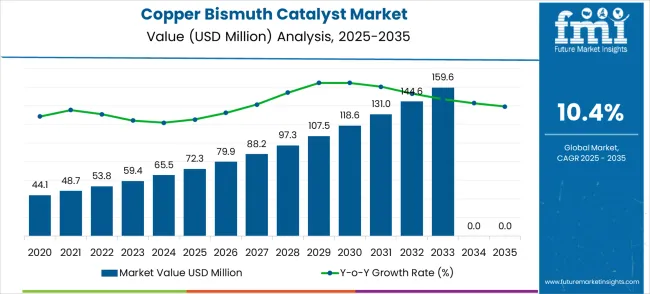
From a growth driver perspective, the period between 2029 and 2032 is marked by accelerated adoption of Copper Bismuth catalysts in specialty chemical processes and polymer synthesis. Annual market growth spikes, such as USD 11.1 million from 2028 to 2029 and USD 12.4 million from 2031 to 2032, align with increased investment in green chemistry technologies and expansion of production capacities in Asia-Pacific and Europe. Policy shifts supporting green manufacturing processes and rising consumer demand for environmentally responsible products are key growth drivers during this phase.
| Metric | Value |
|---|---|
| Estimated Value in (2025E) | USD 72.3 million |
| Forecast Value in (2035F) | USD 194.6 million |
| Forecast CAGR (2025 to 2035) | 10.4% |
Market restraints also play a role in shaping growth patterns. Raw material price volatility for copper and bismuth can affect catalyst production costs, potentially slowing adoption rates in certain years. Economic slowdowns or disruptions in global supply chains could also constrain growth, particularly in mid-decade years. Regulatory hurdles for new catalyst approvals in highly regulated sectors such as pharmaceuticals may temporarily limit market expansion despite rising demand. These factors suggest that certain years, such as 2027 and 2030, might see slight deceleration compared to adjacent years, although overall long-term growth remains positive.
Inflection points are evident in the data, particularly around 2029 and 2032, where YoY growth accelerates noticeably. The shift reflects both technological maturation and increased commercial scale adoption. After 2032, growth stabilizes into a steady upward trajectory, with annual increments such as USD 16.6 million from 2034 to 2035. This reflects a mature market phase driven by demand, innovation in catalyst efficiency, and expansion of green production processes. The market is positioned for robust growth shaped by technology, policy, and industry adoption patterns.
Market expansion is being supported by the increasing global demand for eco-friendly chemical production and the corresponding need for selective catalytic systems that can provide superior oxidation performance and environmental benefits while maintaining process efficiency across various chemical manufacturing and specialty polymer applications. Modern chemical manufacturers are increasingly focused on implementing catalytic solutions that can maximize selectivity, reduce by-product formation, and provide consistent performance in demanding industrial environments. Copper bismuth catalysts' proven ability to deliver superior selectivity, enhanced environmental compatibility, and reliable catalytic performance make them essential components for contemporary green chemical manufacturing and green chemistry solutions.
The growing focus on environmental regulations and green manufacturing is driving demand for copper bismuth catalysts that can support eco-friendly production processes, reduce waste generation, and enable efficient chemical conversion with minimal environmental impact. Chemical processing companies' preference for catalysts that combine high performance with environmental responsibility and economic viability is creating opportunities for innovative copper bismuth catalyst implementations. The rising influence of circular economy principles and green chemistry trends is also contributing to increased adoption of catalysts that can provide advanced chemical synthesis solutions without compromising process efficiency or environmental compliance.
The market is segmented by classification, application, and region. By classification, the market is divided into oxide type, basic copper carbonate type, and others. Based on application, the market is categorized into tetrahydrofuran (THF), polybutylene terephthalate (PBT), γ-butyrolactone (GBL), polyurethane (PU), and others. Regionally, the market is divided into North America, Europe, East Asia, South Asia & Pacific, Latin America, and the Middle East & Africa.
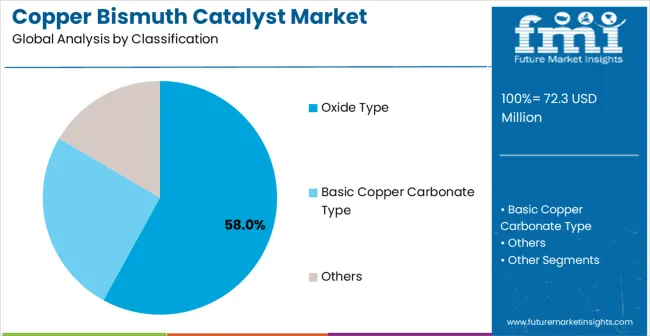
The oxide type segment is projected to account for 58.0% of the copper bismuth catalyst market in 2025, reaffirming its position as the leading classification category. Chemical manufacturers increasingly utilize oxide type copper bismuth catalysts for their superior catalytic activity, proven selectivity performance, and convenience in oxidation reaction applications across THF production, polymer synthesis, and specialty chemical manufacturing operations. Oxide type catalyst technology's established oxidation capabilities and consistent performance output directly address the industrial requirements for reliable chemical synthesis and operational efficiency in selective oxidation processes.
This classification segment forms the foundation of modern selective oxidation operations, as it represents the catalyst type with the greatest application versatility and established market demand across multiple chemical manufacturing categories and process requirements. Chemical plant investments in enhanced oxide type catalyst technologies and process optimization continue to strengthen adoption among chemical producers. With manufacturers prioritizing consistent performance and proven selectivity, oxide type copper bismuth catalysts align with both operational efficiency objectives and environmental requirements, making them the central component of comprehensive eco-friendly chemical manufacturing strategies.
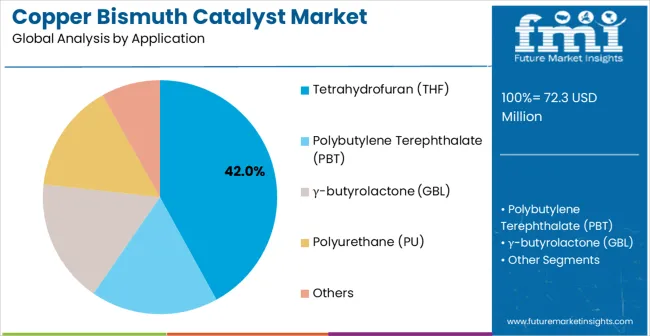
Tetrahydrofuran (THF) applications are projected to represent 42.0% of copper bismuth catalyst demand in 2025, underscoring their critical role as the primary application market for selective oxidation catalysts in THF production and solvent manufacturing facilities. THF manufacturers prefer copper bismuth catalysts for their exceptional selectivity performance, superior conversion efficiency, and ability to produce high-quality THF while maintaining process reliability and environmental compliance. Positioned as essential catalysts for modern THF production, copper bismuth catalysts offer both performance advantages and sustainability benefits.
The segment is supported by continuous growth in THF demand and the growing availability of specialized catalyst technologies that enable efficient THF production with enhanced selectivity and improved process economics. THF manufacturers are investing in advanced catalyst systems to support high-volume production and quality assurance for demanding solvent and polymer applications. As THF consumption continues to grow and environmental requirements increase, THF applications will continue to dominate the end-user market while supporting advanced catalyst utilization and green production strategies.
The market is advancing rapidly due to increasing demand for selective oxidation processes and growing adoption of environmentally friendly catalyst technologies that provide enhanced selectivity and superior sustainability across diverse chemical manufacturing and polymer production applications. The market faces challenges, including raw material cost volatility, technical complexity requirements, and the need for specialized process expertise investments. Innovation in nanotechnology applications and catalyst regeneration continues to influence product development and market expansion patterns.
The growing adoption of basic copper carbonate type formulations and enhanced support systems is enabling chemical catalyst manufacturers to produce premium copper bismuth catalysts with superior selectivity characteristics, enhanced stability, and advanced operational performance. Advanced catalyst systems provide improved chemical performance while allowing more efficient processing and consistent output across various reaction conditions and feedstock compositions. Manufacturers are increasingly recognizing the competitive advantages of advanced catalyst capabilities for product differentiation and premium market positioning in demanding chemical processing segments.
Modern copper bismuth catalyst producers are incorporating nanotechnology and process optimization technologies to enhance catalyst performance, improve reaction selectivity, and ensure consistent delivery to chemical manufacturers and processing facilities. These technologies improve catalytic efficiency while enabling new applications, including enhanced conversion rates and reduced energy requirements. Advanced technology integration also allows manufacturers to support premium positioning and operational excellence beyond traditional catalyst production capabilities.
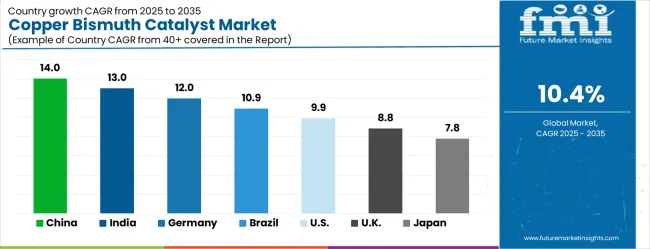
| Country | CAGR (2025-2035) |
|---|---|
| China | 14.0% |
| India | 13.0% |
| Germany | 12.0% |
| Brazil | 10.9% |
| USA | 9.9% |
| UK | 8.8% |
| Japan | 7.8% |
The market is experiencing exceptional growth globally, with China leading at a 14.0% CAGR through 2035, driven by the expanding chemical manufacturing industry, growing polymer production capacity, and significant investment in sustainable catalyst technology infrastructure development. India follows at 13.0%, supported by large-scale chemical industry expansion, emerging catalyst manufacturing facilities, and growing domestic demand for specialty chemical production technologies. Germany shows growth at 12.0%, focusing technological innovation and green catalyst development. Brazil records 10.9%, focusing on chemical industry expansion and environmental technology modernization. The USA demonstrates 9.9% growth, prioritizing advanced chemical technologies and high-performance catalyst solutions. The UK exhibits 8.8% growth, focusing chemical manufacturing capabilities and sustainable catalyst adoption. Japan shows 7.8% growth, supported by precision chemical manufacturing excellence and advanced catalyst technology innovation.
The report covers an in-depth analysis of 40+ countries; top-performing countries are highlighted below.
China is projected to expand at a CAGR of 14.0% from 2025 to 2035, driven by growth in the chemical, polymer, and specialty catalyst industries. Copper bismuth catalysts are essential in selective oxidation, hydrogenation, and fine chemical production processes. Domestic manufacturers are investing in high-efficiency catalyst designs and large-scale production facilities to meet rising demand. Growth is supported by expansion in the chemical intermediates sector, electronics manufacturing, and automotive industries. Government incentives for advanced chemical processing and technology adoption further fuel market growth. Collaborations with global catalyst suppliers allow technology transfer, enabling higher yields and lower production costs. Rising exports of specialty chemicals and polymers strengthen China’s position as a key global producer of copper bismuth catalysts.
India is expected to grow at a CAGR of 13.0% during 2025–2035, supported by increasing demand in fine chemicals, pharmaceuticals, and polymer manufacturing. Copper bismuth catalysts are used for oxidation reactions, specialty chemical synthesis, and environmental applications. Domestic manufacturers are investing in process optimization and catalyst efficiency to meet growing demand. Expansion of the pharmaceutical sector, textile processing, and chemical intermediates production drives market growth. Government initiatives to strengthen the chemical industry and increase domestic manufacturing capacity support catalyst adoption. Strategic partnerships with international catalyst developers ensure access to advanced technologies and high-quality catalyst materials, enhancing India’s competitiveness in the global market.
Germany is expected to grow at a CAGR of 12.0% from 2025 to 2035, driven by demand in fine chemicals, polymer production, and specialty manufacturing. Copper bismuth catalysts are valued for their high selectivity, durability, and application versatility. German manufacturers focus on high-performance catalyst blends, automation integration, and environmental compliance. Demand is fueled by the automotive, electronics, and chemical intermediates sectors. Strong investment in research and development allows Germany to lead in catalyst innovation, especially for ecofriendly chemical processes. Collaborations between research institutions and catalyst manufacturers drive efficiency improvements and cost reductions. Strict EU regulations ensure the adoption of advanced, eco-friendly catalysts, reinforcing Germany’s role as a key catalyst technology hub.
Brazil is projected to grow at a CAGR of 10.9% from 2025 to 2035, supported by demand from the polymer, chemical, and pharmaceutical sectors. Copper bismuth catalysts are increasingly adopted for high-value synthesis and oxidation processes. Local manufacturers focus on cost-efficient catalyst production while importing advanced catalysts for specialized applications. Growth is driven by expansion in polymer production for automotive and packaging industries and by increasing pharmaceutical manufacturing. Government regulations promoting efficient and environmentally friendly chemical processes support adoption. Strategic collaborations with global catalyst firms enhance technical capabilities and improve yields. Rising exports of specialty polymers and chemicals strengthen catalyst consumption in Brazil.
The United States is expected to grow at a CAGR of 9.9% during 2025–2035, driven by demand from chemical manufacturing, polymers, pharmaceuticals, and specialty chemicals. Copper bismuth catalysts are critical in selective oxidation and high-value chemical synthesis. Manufacturers are focusing on improving catalyst activity, optimizing production processes, and integrating automation to reduce costs. Growth is supported by expanding production of engineering plastics, specialty chemicals, and eco-friendly materials. Stricter environmental regulations encourage the adoption of advanced catalysts with higher efficiency and lower emissions. Collaborations with European and Asian catalyst firms allow access to advanced technologies and quality improvements, enhancing competitiveness in global markets.
The United Kingdom is forecasted to grow at a CAGR of 8.8% during 2025–2035, driven by demand in specialty chemicals, polymer synthesis, and pharmaceuticals. Copper bismuth catalysts are used extensively for high-value chemical production and environmental applications. UK manufacturers focus on catalyst efficiency, green production processes, and cost optimization to maintain competitiveness. Growth is supported by increasing demand for eco-friendly materials in automotive and packaging sectors. Collaborations with global catalyst developers ensure access to advanced technology and improved production yields. Regulatory pressure for green production processes further strengthens the adoption of copper bismuth catalysts. Rising exports of high-value specialty chemicals also boost demand.
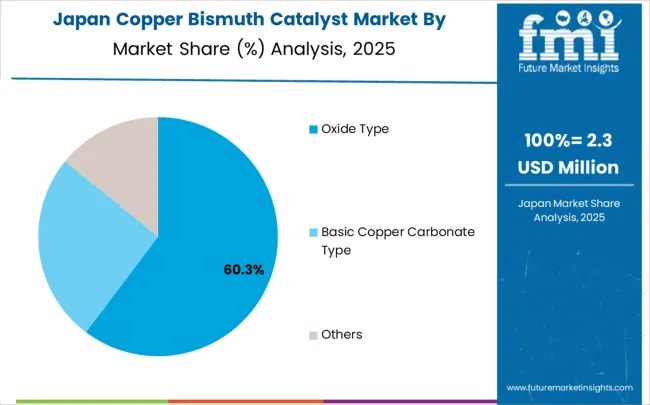
Japan is projected to grow at a CAGR of 7.8% from 2025 to 2035, driven by demand in fine chemicals, polymer production, and electronics manufacturing. Copper bismuth catalysts are valued for their selectivity, efficiency, and environmental benefits. Japanese manufacturers focus on catalyst purity, energy efficiency, and advanced manufacturing processes. Growth is supported by strong automotive manufacturing, electronics production, and chemical intermediates synthesis. Collaborative research initiatives with international catalyst developers strengthen innovation, while stringent environmental regulations promote adoption of advanced, eco-friendly catalysts. Export demand for high-quality chemicals also contributes to market expansion, positioning Japan as a key player in the global copper bismuth catalyst market.
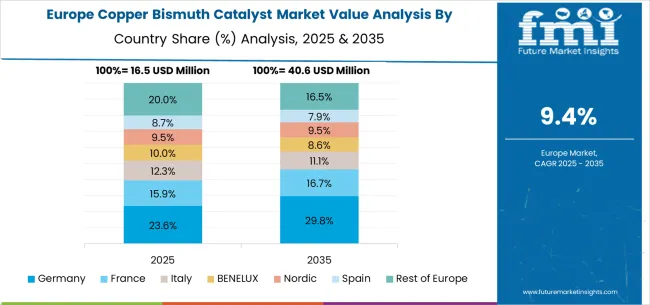
The copper bismuth catalyst market in Europe is projected to grow from USD 15.9 million in 2025 to USD 42.8 million by 2035, registering a CAGR of 10.4% over the forecast period. Germany is expected to maintain its leadership position with a 25.0% market share in 2025, declining slightly to 24.5% by 2035, supported by its strong chemical manufacturing industry, advanced catalyst production facilities, and comprehensive green manufacturing supply network serving major European markets.
France follows with an 18.0% share in 2025, projected to reach 18.3% by 2035, driven by robust demand for copper bismuth catalysts in chemical manufacturing, polymer production, and specialty chemical applications, combined with established chemical traditions incorporating eco-friendly catalyst technologies. The United Kingdom holds a 16.5% share in 2025, expected to decrease to 16.2% by 2035, supported by strong chemical sector demand but facing challenges from competitive pressures and industrial restructuring. Italy commands a 14.0% share in 2025, projected to reach 14.2% by 2035, while Spain accounts for 12.0% in 2025, expected to reach 12.2% by 2035. The Netherlands maintains a 4.0% share in 2025, growing to 4.2% by 2035. The Rest of Europe region, including Nordic countries, Eastern Europe, Portugal, Belgium, Switzerland, and Austria, is anticipated to gain momentum, expanding its collective share from 10.5% to 10.6% by 2035, attributed to increasing adoption of sustainable chemical technologies in Nordic countries and growing catalyst manufacturing activities across Eastern European markets implementing green chemistry modernization programs.
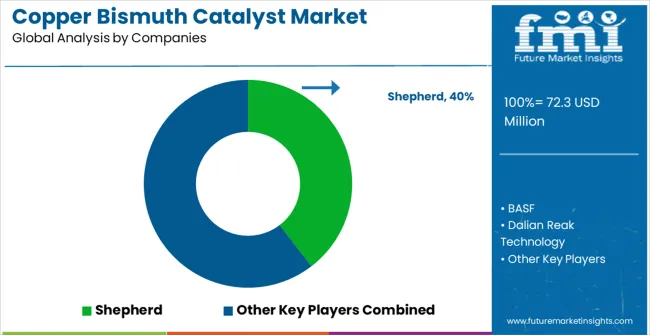
The market is competitive, driven by product purity, catalytic efficiency, and regulatory compliance for industrial chemical synthesis. BASF and Shepherd lead with advanced formulations that deliver consistent performance in fine chemical and pharmaceutical production. Their competitive strength lies in established manufacturing infrastructure, global distribution networks, and robust technical support. Product brochures emphasize high catalytic activity, resistance to deactivation, and stability under demanding reaction conditions, appealing to large-scale industrial manufacturers seeking reliable catalyst solutions.
Dalian Reak Technology and Sunchem compete by offering cost-effective catalysts tailored for regional markets and specialized chemical processes. Dalian Reak Technology focuses on optimized catalyst formulations with extended lifecycle performance, targeting chemical producers in Asia. Sunchem differentiates through flexibility in production scale and custom catalyst solutions, addressing specific process requirements and client needs. Both firms emphasize process efficiency and reduced waste generation, enhancing operational sustainability for their customers.
Competition in this market is defined by catalyst performance, regulatory adherence, and supply chain reliability. Leading players invest in R&D to enhance catalytic activity, refine alloy composition, and improve manufacturing efficiency. Smaller and regional suppliers leverage affordability, specialized formulations, and responsive customer support to capture niche opportunities. Product brochures consistently highlight catalyst purity, efficiency under varied reaction conditions, and compatibility with industrial processes, maintaining competitiveness in a market shaped by innovation, precision manufacturing, and targeted application expertise.
| Items | Values |
|---|---|
| Quantitative Units (2025) | USD 72.3 million |
| Classification | Oxide Type, Basic Copper Carbonate Type, Others |
| Application | Tetrahydrofuran (THF), Polybutylene Terephthalate (PBT), γ-butyrolactone (GBL), Polyurethane (PU), Others |
| Regions Covered | North America, Europe, East Asia, South Asia & Pacific, Latin America, Middle East & Africa |
| Countries Covered | United States, Canada, United Kingdom, Germany, France, China, Japan, South Korea, India, Brazil, Australia and 40+ countries |
| Key Companies Profiled | Shepherd, BASF, Dalian Reak Technology, and Sunchem |
| Additional Attributes | Dollar sales by classification and application category, regional demand trends, competitive landscape, technological advancements in catalyst systems, selectivity innovation, and process optimization |
North America
Europe
East Asia
South Asia & Pacific
Latin America
Middle East & Africa
The global copper bismuth catalyst market is estimated to be valued at USD 72.3 million in 2025.
The market size for the copper bismuth catalyst market is projected to reach USD 194.6 million by 2035.
The copper bismuth catalyst market is expected to grow at a 10.4% CAGR between 2025 and 2035.
The key product types in copper bismuth catalyst market are oxide type, basic copper carbonate type and others.
In terms of application, tetrahydrofuran (thf) segment to command 42.0% share in the copper bismuth catalyst market in 2025.






Our Research Products

The "Full Research Suite" delivers actionable market intel, deep dives on markets or technologies, so clients act faster, cut risk, and unlock growth.

The Leaderboard benchmarks and ranks top vendors, classifying them as Established Leaders, Leading Challengers, or Disruptors & Challengers.

Locates where complements amplify value and substitutes erode it, forecasting net impact by horizon

We deliver granular, decision-grade intel: market sizing, 5-year forecasts, pricing, adoption, usage, revenue, and operational KPIs—plus competitor tracking, regulation, and value chains—across 60 countries broadly.

Spot the shifts before they hit your P&L. We track inflection points, adoption curves, pricing moves, and ecosystem plays to show where demand is heading, why it is changing, and what to do next across high-growth markets and disruptive tech

Real-time reads of user behavior. We track shifting priorities, perceptions of today’s and next-gen services, and provider experience, then pace how fast tech moves from trial to adoption, blending buyer, consumer, and channel inputs with social signals (#WhySwitch, #UX).

Partner with our analyst team to build a custom report designed around your business priorities. From analysing market trends to assessing competitors or crafting bespoke datasets, we tailor insights to your needs.
Supplier Intelligence
Discovery & Profiling
Capacity & Footprint
Performance & Risk
Compliance & Governance
Commercial Readiness
Who Supplies Whom
Scorecards & Shortlists
Playbooks & Docs
Category Intelligence
Definition & Scope
Demand & Use Cases
Cost Drivers
Market Structure
Supply Chain Map
Trade & Policy
Operating Norms
Deliverables
Buyer Intelligence
Account Basics
Spend & Scope
Procurement Model
Vendor Requirements
Terms & Policies
Entry Strategy
Pain Points & Triggers
Outputs
Pricing Analysis
Benchmarks
Trends
Should-Cost
Indexation
Landed Cost
Commercial Terms
Deliverables
Brand Analysis
Positioning & Value Prop
Share & Presence
Customer Evidence
Go-to-Market
Digital & Reputation
Compliance & Trust
KPIs & Gaps
Outputs
Full Research Suite comprises of:
Market outlook & trends analysis
Interviews & case studies
Strategic recommendations
Vendor profiles & capabilities analysis
5-year forecasts
8 regions and 60+ country-level data splits
Market segment data splits
12 months of continuous data updates
DELIVERED AS:
PDF EXCEL ONLINE
Copper(II) Carbonate Basic Market Size and Share Forecast Outlook 2025 to 2035
Copper Chrome Black Market Size and Share Forecast Outlook 2025 to 2035
Copper and Aluminum Terminal Blocks Market Size and Share Forecast Outlook 2025 to 2035
Copper Coated Film Market Size and Share Forecast Outlook 2025 to 2035
Copper Foil Rolling Mill Market Forecast and Outlook 2025 to 2035
Copper and Aluminum Welding Bar Market Size and Share Forecast Outlook 2025 to 2035
Copper Pipes and Tubes Market Size and Share Forecast Outlook 2025 to 2035
Copper Chromite Black Pigment Market Size and Share Forecast Outlook 2025 to 2035
Copper Cabling Systems Market Size and Share Forecast Outlook 2025 to 2035
Copper and Brass Flat Products Market Size and Share Forecast Outlook 2025 to 2035
Copper Oxychloride Market Size and Share Forecast Outlook 2025 to 2035
Copper and Copper Alloy Scrap and Recycling Market Size and Share Forecast Outlook 2025 to 2035
Copper Fungicides Market Size and Share Forecast Outlook 2025 to 2035
Copper Tube Market Size and Share Forecast Outlook 2025 to 2035
Copper Foil Market Growth - Trends & Forecast 2025 to 2035
Copper Azoles Market
Beryllium Copper for Consumer Electronics Market Size and Share Forecast Outlook 2025 to 2035
Beryllium Copper for Telecommunication Market Size and Share Forecast Outlook 2025 to 2035
Beryllium Copper for Automobile Market Size and Share Forecast Outlook 2025 to 2035
Beryllium Copper Plate Market Size and Share Forecast Outlook 2025 to 2035

Thank you!
You will receive an email from our Business Development Manager. Please be sure to check your SPAM/JUNK folder too.
Chat With
MaRIA